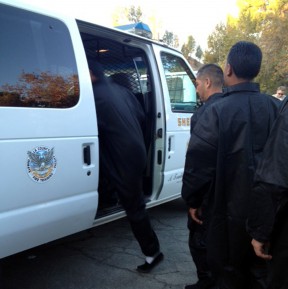 The first 20 inmates were transferred from Los Angeles County Jail to the Los Angeles County Fire Department Inmate Fire Suppression Camps on Wednesday.
The first 20 inmates were transferred from Los Angeles County Jail to the Los Angeles County Fire Department Inmate Fire Suppression Camps on Wednesday.
The transfer took place at Holton Conservation Camp (Los Angeles County Fire Camp 16), in Sylmar. The Fire Camps are a joint venture of the Los Angeles County Fire Department, Los Angeles County Sheriff’s Department, and the California Department of Corrections and Rehabilitation. The Sheriff’s Department has contracted with the California Department of Corrections and Rehabilitation to send up to 528 inmates to the Fire Camps.
The inmates are part of the Public Safety Realignment Plan (AB109), which places lower security level inmates (“N3”, Nonviolent, Non-serious, Non-sexual) in the custody of local law enforcement agencies. The Department of Corrections and Rehabilitation has for decades assigned lower-level offenders to live and work in rural fire camps. However, that segment of the prison inmate population has fallen significantly since AB109 took effect. Starting in October 2011, offenders who commit non-violent, non-serious, non-sex offense crimes are sent to county jails or some other form of local supervision. The Sheriff’s Department is drawing from that offender population to help staff the county’s fire camps. To fill the vacancies in the five Los Angeles County Fire Department inmate fire camps, the Sheriff’s Department was tasked with selecting, screening, and physically training the men and women who volunteer for the program. Both the Sheriff’s Department and the Department of Corrections and Rehabilitation carefully screen the inmates for security level and medical suitability.
The inmates undergo several weeks of arduous physical conditioning and strenuous work projects, supervised by the staff at the Pitchess Detention Center/Inmate Fire Training Facility in Castaic. The inmates hike three to six miles daily, in the hills and fire trails surrounding the 2600 acre Pitchess Detention Center.
The Fire Department then trains the inmates in an intensive two week, 80 hour, training program encompassing fire behavior, fire line safety, fire line hazards and use of hand tools, as well as standards of behavior and professionalism. The Fire Department has a long history of training inmates at the Pitchess Detention Center, and utilizes many existing training resources.
The incentive for inmates working on a fire crew includes earning an additional day of work credit off their remaining sentence, working on a daily basis instead of sitting idle in a jail cell, but also job opportunities when they are released. Many federal and state fire agencies do hire felons who have experience working on inmate fire crews (Bureau of Land Management, Bureau of Indian Affairs, United States Forest Service, CALFIRE).
The Sheriff’s Department plans on training 500-700 inmates a year in the program, which not only ensures a steady supply of fire crews, but also aids in freeing up additional bed space in the county jail system. The ultimate goal of the program is to help turn the lives of these men and women around, to raise their self-esteem, and break the cycle of returning to jail.
First of 528 Inmates Sent to Fight Fires After Training in Castaic